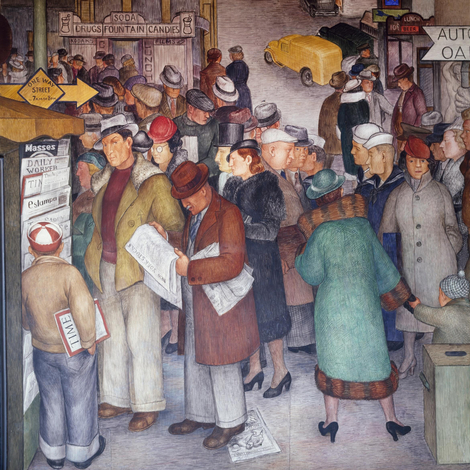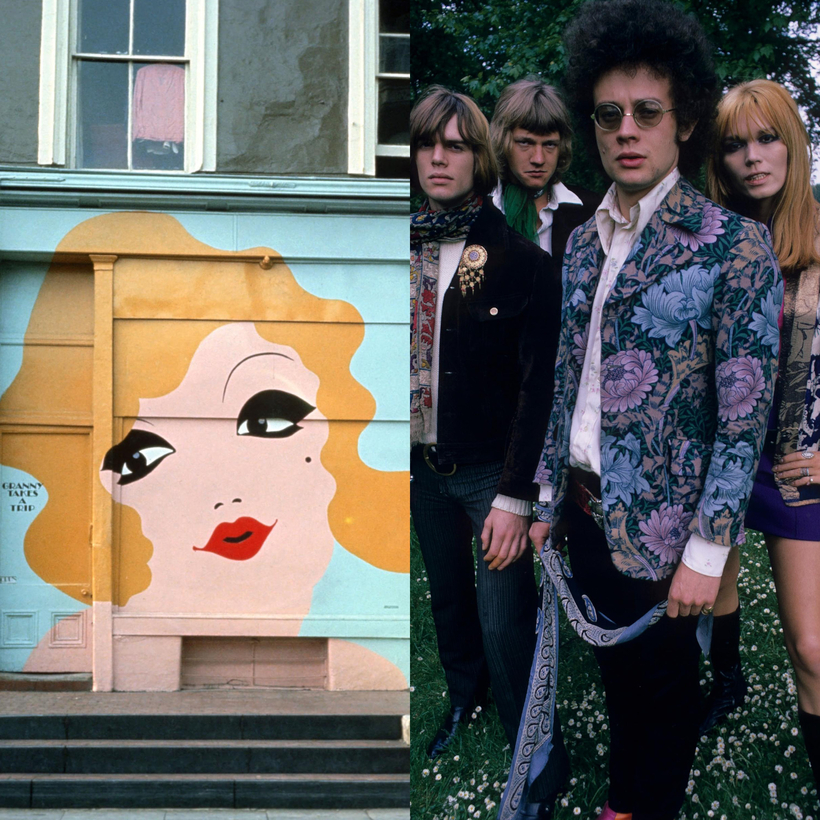During the sun-dappled London summer of 1967, a King’s College student named Salman Rushdie rented a room upstairs at 488 King’s Road in the aptly named World’s End area of Chelsea. The location—sleepy, vaguely bohemian—was inconveniently out of the way. But it was then undergoing a kaleidoscopic transformation, along with all of London, thanks in part to the outré clothing shop that inhabited the ground floor of No. 488 and went by the eyebrow-raising name of Granny Takes a Trip.
The era-defining boutique is now the subject—and title—of a stylish cultural history by the British writer Paul Gorman, just out from Hachette Mobius. Granny Takes a Trip is itself a kind of charmingly crammed bazaar, chockablock with photographs, illustrations, and no end of tall tales from the sundry rock stars, artistes, and socialites who patronized a retail institution that put the swing into Swinging London.
As Rushdie remembered it, “Granny’s people” were as scornful of plain-Jane Sloane Rangers as they were of Carnaby Street trend-chasers. They would never deign to say “fab” or “groovy”; everything was “beautiful.” The psychedelic music that poured from the shop hi-fi was loud enough to compete with a Learjet; the décor ran to Beardsley prints, Victorian erotica, and a horn gramophone.

To a student such as Rushdie, the coolness consciousness on vivid display—not to mention the inventory of frilly Byronic shirts, flared trousers, and the like—was downright intimidating. When he attempted to break the ice with one of the owners, the twentysomething Sheila Cohen, she gave the hapless undergrad a once-over and muttered, “Conversation’s dead, man.”
Cohen was, in fact, extremely fluent in the recondite discourse that is fabrics, seams, drapes, textures, colors. She had been a collector of Victorian clothing when she opened the shop, in 1966, with her painter boyfriend, Nigel Waymouth, along with his pal John Pearse, a precocious young tailor who had been training with the Jermyn Street tailors Hawes & Curtis since 1960, when he was all of 15.

“We have Henley picnic suits, frock coats, band masters’ coats with frogging, ruffled and lacy shirts,” Waymouth informed a curious reporter. “We even found dresses from Doucet and Paquin in Paris that were made for Princess Esterhazy.” Each piece was a little treasure that the proprietors had hunted down and were now sharing with the public; these were mixed with new, flamboyant designs created according to their whims. Shirts—with swirling patterns and floppy collars—went for six guineas a pop, the equivalent of around $200 today.
Business started out slow. Then one morning, while Cohen, Waymouth, and Pearse were sitting around the shop sharing a joint, the front door opened and Liverpudlian accents came flooding in: “Well, this is a nice place, isn’t it?” It was John Lennon and Paul McCartney, who became converts on the spot. The Beatles ended up wearing shirts from Granny Takes a Trip on the back of Revolver (a picture taken during a video directed by Air Mail contributor Michael Lindsay-Hogg). Naturally, the Rolling Stones then got themselves done up in Granny gear for the cover of Between the Buttons. A tipping point had been reached.

Brian Jones and Anita Pallenberg were spotted in the store’s back room. John Paul Getty II swung by and bought a suede coat. Henrietta Moraes, the muse and model of Lucian Freud and Francis Bacon, bought a pair of boots fashioned from William Morris fabrics. (“They laced up to the knee,” she remembered, “and, depending on how stoned I was, took at least ten minutes to put on.”)
Barbra Streisand stopped in, as did various Warhol people. Faye Dunaway modeled Granny pieces in Vogue. Kenney Jones, of the Small Faces, was set to open his wallet for a pair of green velvet trousers—until he was told that Jimi Hendrix had just tried on the same pair. “Everybody was getting crabs,” Jones recalled, “and I didn’t want Jimi’s!”

As Granny caught on, an ever widening swath of the population started to peacock out, prompting the London taste-maker Christopher Gibbs to observe, “It actually became quite difficult to suss out who was a pop star and who wasn’t.”
In Gorman’s adept hands, the story of Granny Takes a Trip becomes a free-ranging exploration of retail in the 1960s, with men embracing fashion for the first time and vanguard boutiques—Hung on You, Biba, I Was Lord Kitchener’s Valet, Dandie Fashions—sprouting across London. Gorman finds the roots of fast fashion in Granny, as High Street shops began retailing Granny-ified hippie togs to the masses.

He gamely explores the many social and cultural byways radiating from the shop, not to mention a riotously colorful cast of Swinging Londoners, such as the ill-fated Guinness heir Tara Browne, whose fatal car accident in December 1966 prompted the Beatles’ “A Day in the Life”; Amanda Lear, the high-flying French model, socialite, and muse to Salvador Dalí who called herself Peki d’Oslo; and the “It girl” Iggy the Inuit, who wasn’t even named Iggy and possibly wasn’t Inuit.
By the end of the decade (when Joe Cocker wore Granny boots onstage at Woodstock), the vibes were beginning to curdle. Cohen et al. sold their labor of love in 1969 to Freddie Hornik, a guy who knew the value of pure hustle. He expanded into New York (the former Granny location on East 62nd Street is now, aptly enough, a cannabis store) and Los Angeles.

Throughout the 1970s, despite changing tastes, the rockoisie continued to favor Granny’s trademark blend of flash and trash: Elton John on the cover of Caribou, Lou Reed on the cover of Transformer. In 1974, the Who’s bibulous drummer, Keith Moon, showed up at the L.A. shop needing an outfit for the Oscars that very night, a deliberation that ended up involving the shop’s entire stock: “I won’t be rushed! This is the fucking Oscars, you pillock!” Moon at last chose an embroidered bolero jacket and matching trousers at 11 p.m.—too late for the ceremony—and attempted to pay with half of a credit card. (In true Granny style, he was allowed to walk out with the merchandise.)
Granny Takes a Trip didn’t survive the era of New Wave and New Romantics, but the legacy of what Pete Townshend once called “London’s home of motley garb” lives on in museum shows, auctions, and a society that has long learned to dress however it pleases—even if it finds pleasure in comparatively understated raiment these days. Summing up the Granny way of being, Gorman swipes a line from Oscar Wilde, one that could serve as both epigraph and epitaph: “One should be a work of art or wear a work of art.”
Mark Rozzo is an Editor at Large at AIR MAIL and the author of Everybody Thought We Were Crazy: Dennis Hopper, Brooke Hayward, and 1960s Los Angeles


